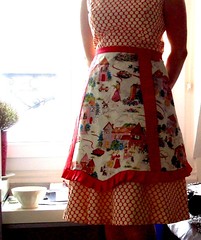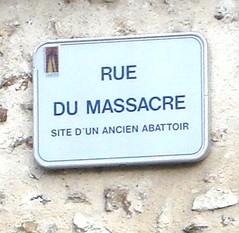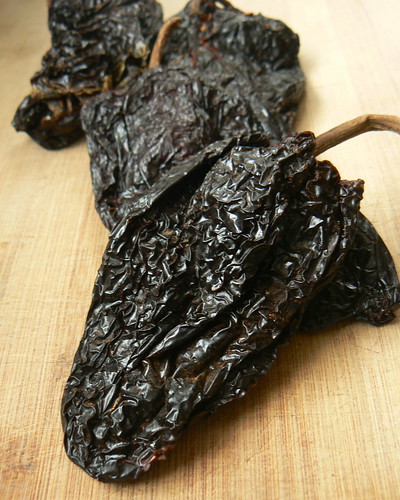
Recipe for Chorizo.
What better way to learn about culture and food than by eating sausage. In today's episode, we take a little trip South of the border as I try to understand how two cultures came together to make this magical mixture, chorizo. Olé!
Chorizo is Spanish for sausage, and there are many kinds of chorizo ranging what we know as fresh chorizo, to Chorizo Verde, to a dry cured Spanish chorizo. In America we are most familiar with the fresh Mexican rojo (red) chorizo, a salty spicy sausage that comes in long pakages. My favorite way to eat it is for breakfast fried up in a hash with peppers and potatoes. But the store packaged stuff is nasty, I want a recipe that uses few ingredients and tastes like chorizo.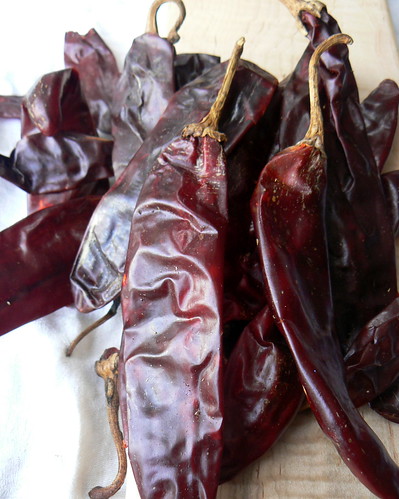
Chile Paste and the Aztec Blender.
The primary flavor for the chorizo is the chile (or chilli, or chili, or pepper). While I have made sausage in the past by just using powdered peppers, I believe you get a better flavor by preparing a chile paste from dried peppers. Here's how I learned to do it in school: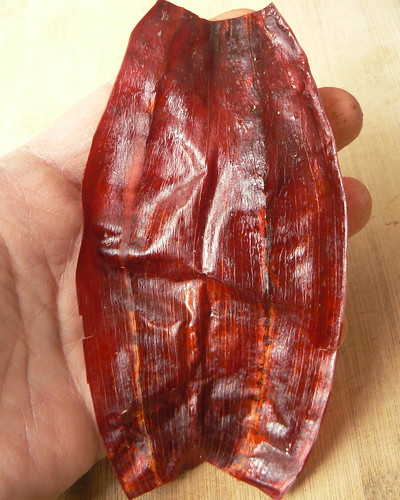
Remove the stems and seeds from the chiles.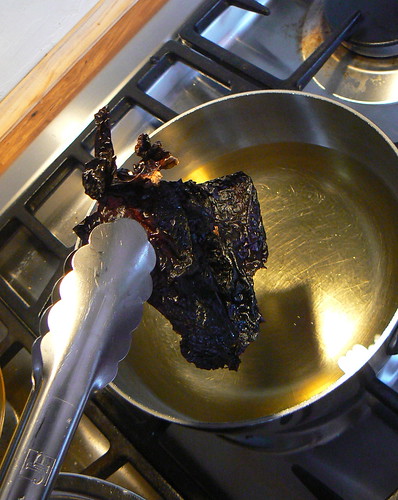
Blanch them in oil. No more than five seconds (really three), or they will they will burn, you'll get the hang of it. Make sure the oil is no more than 350F. Strain and save the chile oil.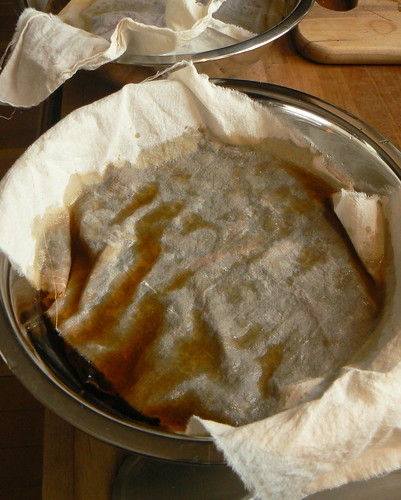
put the blanched chiles in hot tap water, cover with a paper towel and let them hydrate for ten minutes.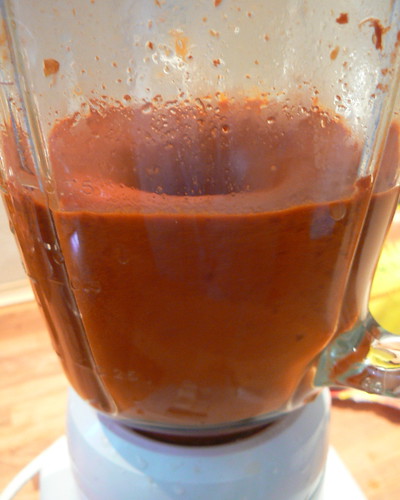
Discard the hydrating water, put the chiles in a blender, add about a cup of water (I started with 3oz (90g) of chiles) and puré. Strain the mixutre.
If you watch a lot of Rick Bayless, you might have noticed that the blender gets used a lot in the Cocina Mexicano.I have often wondered how did this stuff get made before the modern miracle of the West Bend. The Matate made it all possible. It's the three legged grinding stone that for centuries has been in the center of the Mexican kitchen. Up until the turn of the twentieth century a woman in the campesino would spend a third of her life grinding food (corn mostly) on the Matate, "The bitter black stone." Check out ¡Que vivan los tamales!: Food and the Making of Mexican Identity, by Jeffrey Pilcher for a history of the Mexican kitchen.
The meat of the matter.
So you've got your flavorful chile paste what about the meat? Before the Spanish showed up, there wasn't much meat in the Mexican diet, just turkey, iguana, insects and of course fish. With the conquistadors came Mestizo cuisine, a mixture of the two cultures, the Spanish introduced pork, beef and chicken along with rice, garlic and onion. The Spanish also introduced the art of making sausage. I read in Diana Kennedy's book, My Mexico: A Culinary Odyssey with More Than 300 Recipes, "Cortes introduced cattle and pork into the valley (Toluca, famous for sausage...(and) Spanish techniques for sausage making and pork curing naturally followed."
Okay so we have the Mexican Spanish food connection. Let's illustrate it in sausage.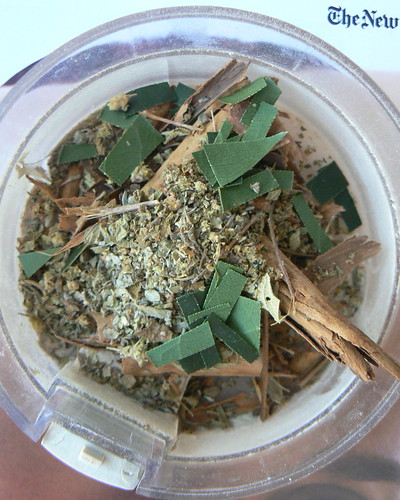
Herbas de olor.
Like the bouquet garni of French cooking, Mexican cuisine has amomatic herbs that serves as a seasoning base: Bay, thyme and marjoram make up the herbas de olor. In some Mexican groceries you can find these three fresh bunched together. I found these herbs in several Chorizo recipes so we will use a little bit. I would recommend trying to find fresh bunches, but in my final recipe I ended up using some dried. I also used some Mexican oregano (because I had some), if you don't have it I wouldn't worry about it too much. Mexican Oregano is not a part of the oregano/marjoram family it's actually related to Lemon Verbena.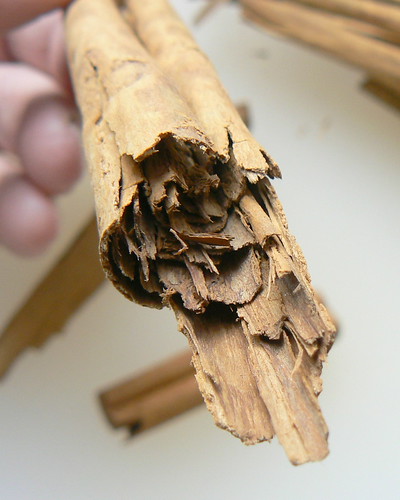
Canela - Cinnamon.
I have known for some time that what we typically call cinnamon is actually cassia, but I hadn't known the difference. In addition when I read recipes calling for "Cinnamon, preferably Mexican" I figured there's a third version from South of the border. Mexican cinnamon is actually true cinnamon and it's imported from Asia. The difference between cinnamon and cassia is dramatic: Cassia is blunt, cinnamon is light and sophisticated. Don't get me wrong, I wont be giving up my cassia for my cinnamon buns, but using Canela, true cinnamon, in moles or chorizo makes a world of difference.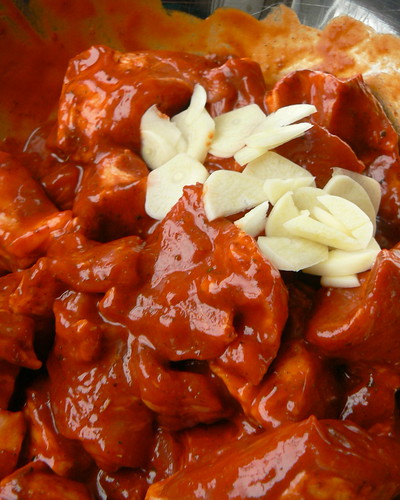
I made up two chiles pastes: guajillo and ancho. Bayless calls the guajillo the "workhorse" of Mexican cuisine, but I would guess the ancho is the most widely used. The guajillo gives beautful color, the ancho provides rich undertones, along with the spices and some garlic, I marinate the pork for an hour.
I made several batches using various combinations of ingredients, I even did a batch with added fat,but I wanted to keep things as simple as possible so I left out the added fat. In all I made about ten pounds of sausage over the past four days.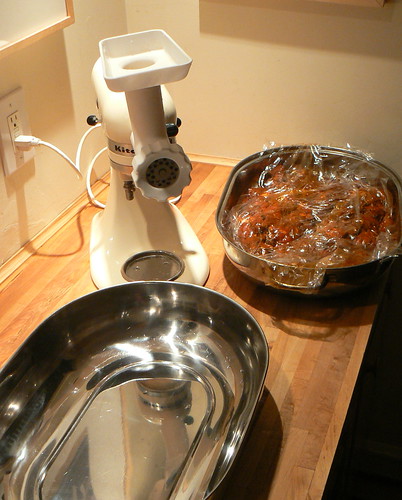
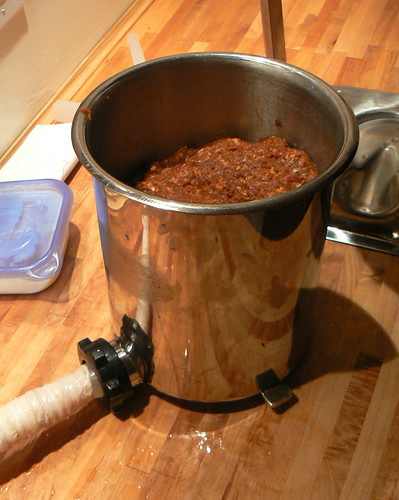
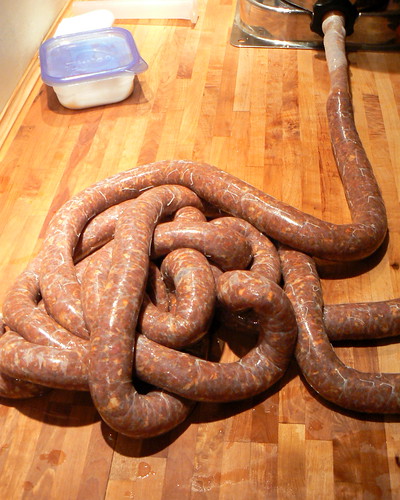
Here's the recipe:
450 g (1 lb) pork shoulder cubed
60g (2oz) Chile paste (I used 50/50 guajillo/ancho, see above for paste instructions)
2 cloves (10 g) of garlic minced.
8 g (1 teaspoon) Salt
4 g cinnamon (for cassia use less, see above)
2 fresh bay leaves minced
1 g dried thyme
1 g dried marjoram
1 g dried Mexican oregano
15 ml (1 Tablespoon) Cider vinegar
Combine cubed pork, chile paste, and garlic. Process salt, herbs and spices in a spice mill and add to mixture. After a rest, run the mass through a grinder. Kneed it adding the vinegar until it starts to come together, about one minute. Stuff into hog casings for that loganzia look.
Chorizo is cooked without a casing, use it for breakfast or for stuffing peppers or for whatever. Enjoy. I gotta get to class.
Cheers.
25 February, 2009
Chorizo
15 February, 2009
09 February, 2009
Kick it to the Curb Tony: My Southside Ain't Gritty

Once again someone from the national media cannot resist the adjective "gritty" when saying the word "Southside." Anthony Bourdain braved our mean streets in a rented caddie for last week's episode of No Reservations. Apparently he made is back North with all his hubcaps in tact. But nobody told him he was parked in the dead guy's spot.
On the episode he visited Calumet Fisheries. I wrote about this place back in November, and last Saturday I had the chance to spend most of the day there taking pictures, talking to the people who work there and observing first hand the power of cable TV.
"I have no idea how they picked us, but this is great." That's Mark Kotlick, one of the owners of Calumet Fisheries. He spent the day gladly talking to inquisitive new customers, discussing the history of the place and showing off the fish that are smoked right outside. "We smoked a week's worth of fish and we might run out today."
Thank you Tony. 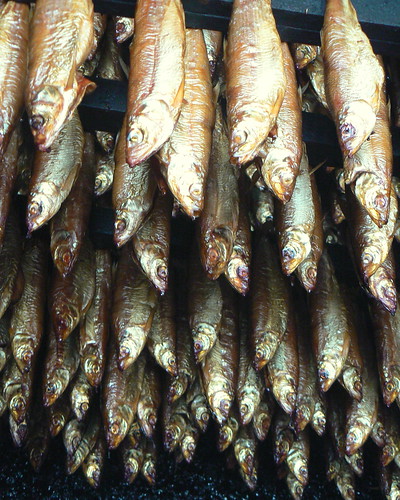
Oh yeah about the dead guy: The manager, Carlos, (who has worked there on and off since 1995, and has a Culinary Certificate from CHIC) told me his story: "I come in one morning and there's a car parked out front, there's usually no cars here, and I notice there's a guy in there. Sleeping. After a few minutes I decide it's time for him to move along and I tap on the window. Nothing. I beat on the window, and I yell and still nothing. Now I'm starting to get a bad feeling. I call 911. A cop shows up, I don't know his name but I recognize him, he opens the door, put his fingers on the guy's neck, then closes the door. The cop says "Yep he's dead. You got any smoked chubs?"
To the guys at Calumet, thanks for letting me spend the day with you, I'll get the photos to you soon.
A different kind of Southside, Pilsen.
If Tony had been a really lucky travelling TV personality, he would have ended up where I was on Sunday, Pilsen. This quarter at Kendall I have Cuisine of Mexico class, and Chef took us on a field trip. 
We visited World Wide Produce at the Chicago International Produce Market Then we went to Cermak Produce Which is a beautiful store, not gritty at all. 
Then Chef led us to El Milagro for fresh masa. We all got a turn feeding the masa machine. 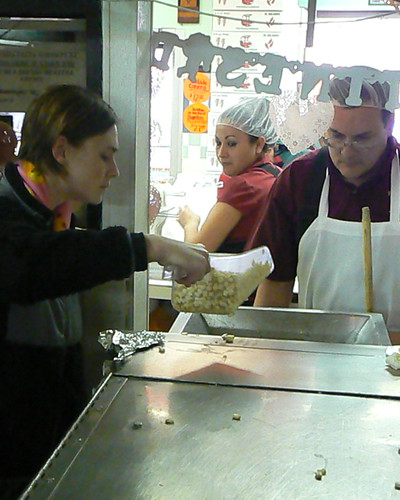
Masa is used for making corn tortillas or tamales. El Milagro also offeres Chicharrones, chips and tortillas, It(1923 S Blue Island Ave, Chicago) was a fun stop.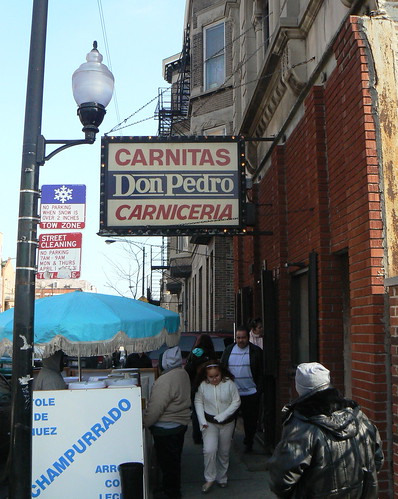
But what Tony really missed out on was Carnerceria Don Pedro. As the name implies, they sell carnitas either to eat in or to go. 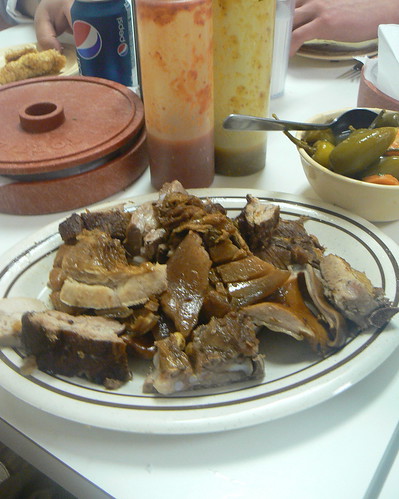
You don't really need a menu because all they serve is carnitas, or if you are not feeling porcine, barbacoa of goat. 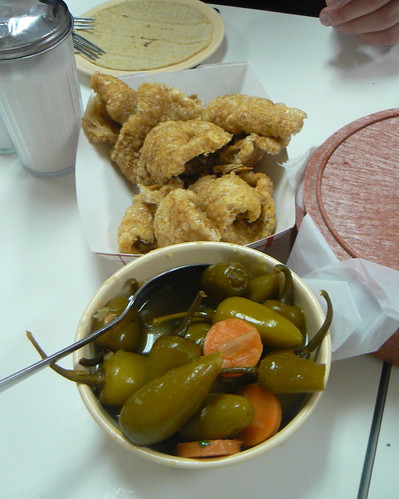
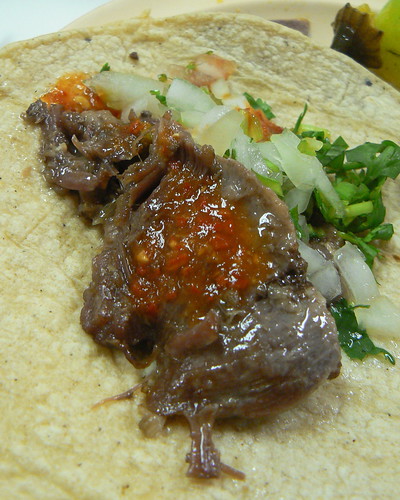
We were served family style with sides chicharrones and jalapenoes escabeche. Chef showed us the proper taco: Some carnitas, crushed chicharrones, onion, cilantro, a squirt of sauce and a squeeze of lime. After lunch Don Pedro showed us the kitchen. 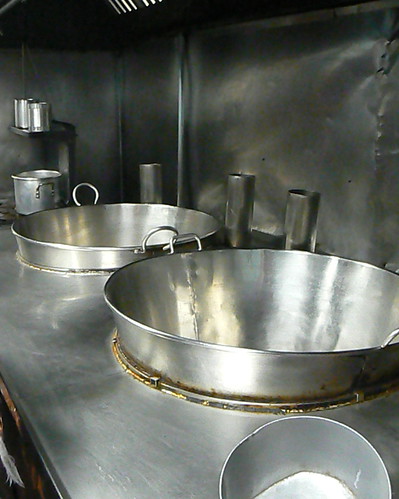
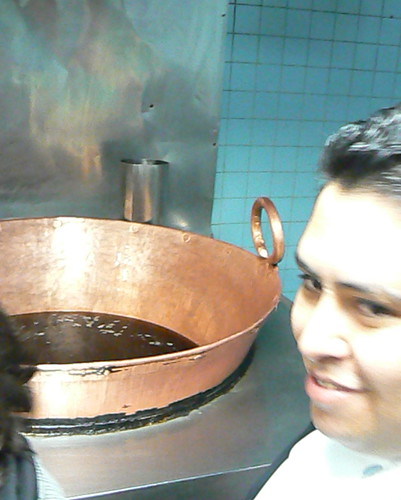
We saw huge kettles where they cook the pork in lard. That right, carnitas are pork confit. Recently I have been reading a lot about chefs getting whole hogs and breaking them down themselves, and making a menu of "nose to tail" dishes. Don Pedro said he goes though fifty whole hogs in a weekend. 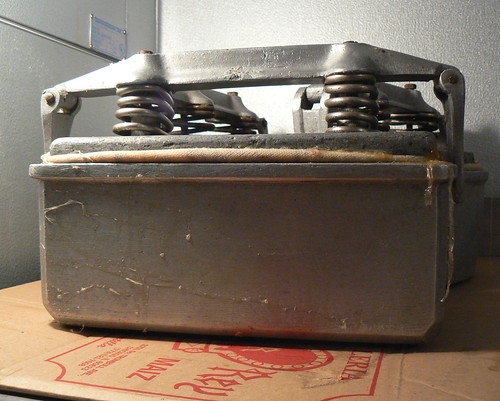
He also makes head cheese and long ropes of sausage. It's nose to tail eating on the cheap. The business there is swift on the weekends with the carryout crowd jamming the front of the room, A man in behind the counter chops at the carnitas in a digit removing fashion, and packs to go orders by the pound. There are maybe ten tables for eating in. And don't show up late, at least not on Sunday. We got there at 1:15 and we got the last of the barbacoa, and they were down to their last tray of carnitas.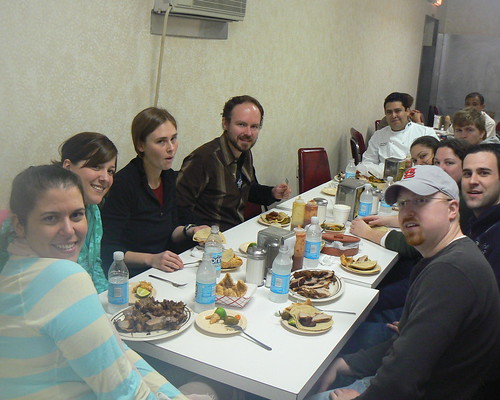
Carnerceria Don Pedro
1113 W 18th ST
Chicago
312-829-4757
Cash Only
Small parking lot just west of the building.
So come visit the Southside. We got more than just grit.
Cheers.
Posted by mac at 21:53 5 comments
Labels: Anthony Bourdain, Calumet Fisheries, Carnitas, Chicago, Culinary school, No Reservations, Southland
01 February, 2009
Seafood Sausage Choucroute
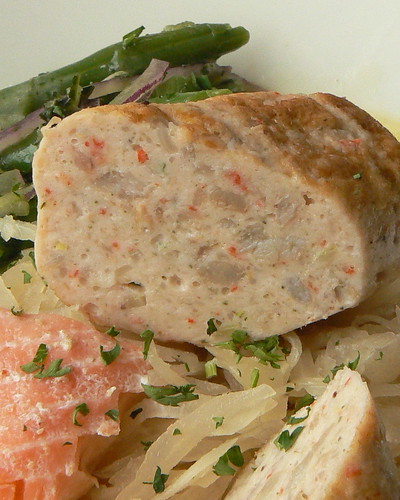
Wish I was a Kellogg's Cornflake
Floatin' in my bowl takin' movies,
Relaxin' awhile, livin' in style,
Talkin' to a raisin who 'casion'ly plays L.A.,
Casually glancing at his toupee.
Wish I was an English muffin
'Bout to make the most out of a toaster.
I'd ease myself down,
Comin' up brown.
I prefer boysenberry
More than any ordinary jam.
I'm a "Citizens for Boysenberry Jam" fan.
Ah, South California...
from Punky's Dilemma, Simon and Garfunkel
Indeed.
I remember hearing this song years ago, its words set the scene, I imagine myself floating in Hockney colors without a worry in the world. A couple of weeks ago we took a trip to South California (Northern San Diego County to be exact)and the scene surpassed our imaginations: Fish tacos, beer and the beach, our winter was warmed. For the trip back, Bonne Femme bought me a Sunset Magazine. At first I snickered thinking of the stacks of old Sunset Publications on the book sale racks at the library. But wait, this mag is kinda good, a hip Better Homes and Gardens, or a Real Simple with a sense of place (and purpose). On the plane I got intrigued by a recipe for Wine Braised Seafood Choucroute. It hits some of my favorite flavor points, Sauerkraut, smoked fish and sausage. It's party time.
A word about Choucroute.
Chou is French for cabbage. Choucroute is French salted cabbage or as my German pals say, Sauerkraut. Choucroute a L'Alsacienne is the comfort food of the Alsace region in which sausages, smoked meats, maybe confits de goose or duck are braised cabbage with a wine broth. But will this work with seafood?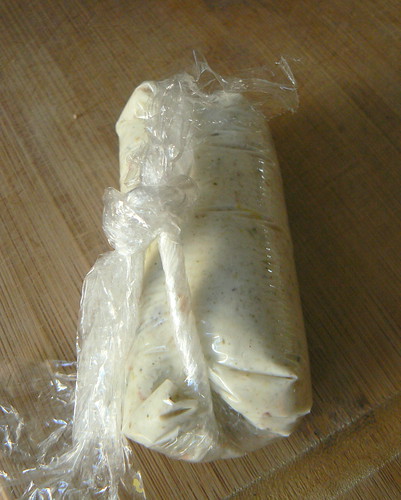
Quenelles.
For the seafood sausage I skip the "gourmet" markets the magazine suggests and turn to Ruhlman and Polcyn's Charcuterie, for a recipe. The Shrimp, Lobster and Leek sausage seems like a good start. As I am reading it I start ruminating about how seafood and sausage really don't go together: The ingredients are expensive and highly perishable, and stuffing a fish mixture into a hog or sheep casing really knocks my Feng Shui out of whack. I look around for other seafood "sausage" recipes, the French must have done something like it. Well they did, only they don't call it sausage. The secret term that links the Charcuterie recipe to culinary history is mousseline forcemeat. Escoffier defines the mousseline forcemeat as preparation of pounded meat whipped together with egg whites and heavy cream. Form this mixture using a spoon, pastry bag, or just rolling it, and you get quenelles. Thems fish balls, yo.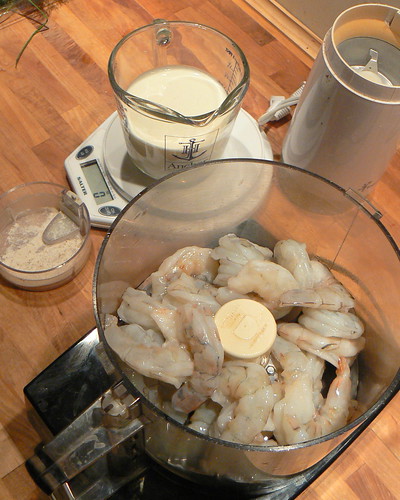
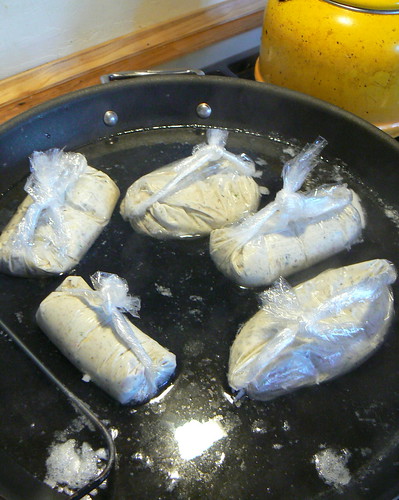
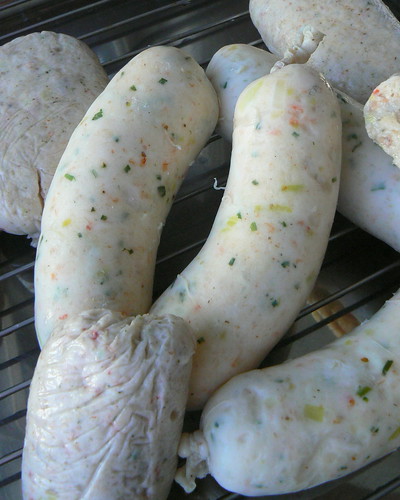
I ended up doing two batches because the recipe only made four 4-1/2oz sausages. The first batch I stuffed into hog casings the second batch I poached in plastic. I used crab instead of lobster.
Braising liquid.
I saved the shrimp shells and sauteed them with a mirepoix of onion, fennel and parsnip. I added a package of bonito flakes for a little extra zip. The addition of wine turns the stock into what pros call a fumet, and Hey Presto, you got yourself a braising liquid for your choucroute.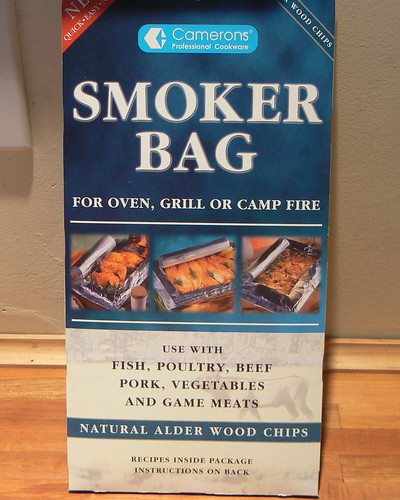
Smoking Fish in the comfort of your home.
I laughed when I first saw these smoker bags at Walt's, I mean what kind of cockamaime tomfoolery is somebody to to foist on me? But when I discovered that these bags were made in Finland, I loaded up. Seriously what the Finns DON'T know about smoking, aint worth knowing. I went to this farmer's market over there where these dudes were selling hams that they had smoked in their Sauna. I gotta get me a sauna.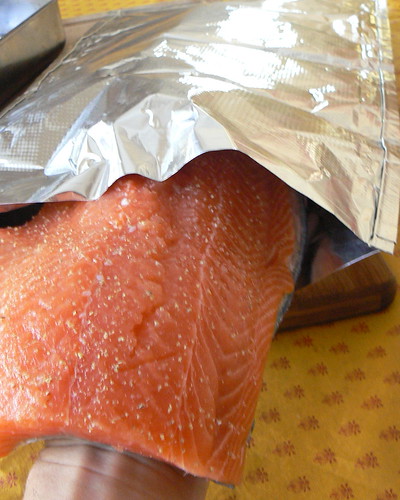
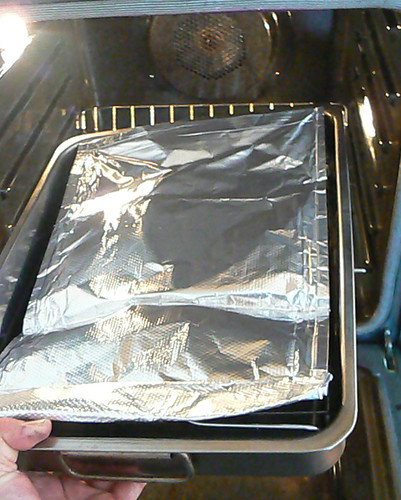
Anyway I loaded the about pound and a half of salmon into the bag folded it shut, and popped it into the oven. I could smell the smoke working, but it wasn't a nuisance. It didn't even come close to setting off a smoke alarm.
20 minutes later I had hot smoked fish. As you can see it's not very pretty and a little undercooked, but that's okay it will finish cooking when we do the braise.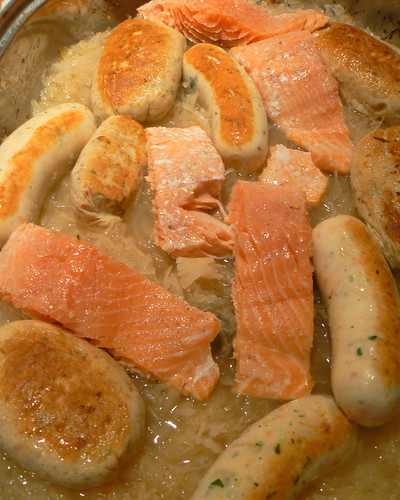
I followed the Sunset recipe and braised the cabbage in the fumet along with some garlic and a sachet containing juniper, thyme, bay leaves and peppercorns. After an hour I added the smoked salmon and the quenelles. I browned the quenelles before adding them. Heat and serve. Everything was delicious and worth the fuss. Here's the recipe I used for the seafood "sausage."
Shrimp and Crab Sausage (Quenelles)
1lb/450 g large (16-20 ct) Shrimp peeled deveined.
8 g (1 teaspoon) salt
2 g ground white pepper
1 large egg white
100-150 ml heavy cream
2 g dry tarragon
50 g leeks, chopped fine, blanched
55 g crab (whatever you can afford)
Use a food processor puree shrimp with salt pepper and egg white. With machine running add heavy cream, keep an eye on the mixture you don't want it to get too loose. And make sure everything stays very cold. Transfer to a bowl and fold in remaining ingredients. Chill. Stuff into casings or roll in plastic then gently poach until done.
I adapted this recipe from Charcuterie with input from Escoffier and Larousse.
Cheers.
Posted by mac at 13:42 10 comments
Labels: Fish, French Cooking, Quenelles, Seafood Sausage, Smoking
30 January, 2009
13 January, 2009
The Paris Beat: Christmas and Croissant Lesson
Dear Macmac:
First of all, happy new years to you. I hope that you had a great holidays and enjoyed your time slaving over the smoker for the relatives. I myself had a great time. . .especially cooking with the crew in a real life sized kitchen. We whipped up several batches of pain raisin, pain au chocolat, ham & cheese croissants and a buche de noel complete with very real looking Italian meringue mushrooms!
I think I am now at the point where I feel like croissants are in the bag. It’s no longer a serious production to put them together and a little advance planning makes things really simple. So what has caused this? Besides plenty of practice, two pieces of information thanks to my fantastic chefs at cordon bleu. Firstly, the detrempe (or initial dough mass) does not, should not in fact, be kneaded. Oh, if only I had known this before I broke mom’s kitchenaid while working up dough for croissants. Ok, so all you do is dump everything together in a bowl and stir it up so that everything in well combined (the flour, yeast (instant or fresh), sugar, salt, water). Let this marinate overnight in the fridge. C’est ca. The kneading is not necessary because you are going to be giving the dough enough of a workout as you do your turns (or folding). Which brings me to my second major lesson: croissants only need three simple turns. In my pre-cordon bleu days, I always did six. This is what Dionne Lucas recommended, so I thought it must be. As it turns out, three is enough (but puff still wants six, ok!). So when it comes to folding in the butter, you do two simple turns, chill 15 min, then one final turn, cut, shape, rise and bake. Or if you have the time, let the dough rest overnight. I’ve gotten much better flavors this way. We have these real fancy proofing machines at school set at ideal rising conditions. Well, when these were full, chef put our croissants in a very low oven for a rise. And it works: instead of taking 2 hours, I get properly risen croissants in less than 30 min. Careful though, if the oven is too warm, the butter will leak out and that is no good. An oven temp of around 90 f or 50 c is ideal for rising. Oh, do I have one more pearl: egg wash. Two coats is the best, with one coat done before rising and another done just before they go into the oven. Best looking croissants you ever saw, deep golden brown beauties.

Now what! Pain aux raisins is a very yummy, easy thing to do with croissant dough. Roll out a rectangle of dough, maybe 12x20 inches. Arrange the dough so that the short side is facing you. Roll out one short end so thing it is basically smashed on to the counter (super thin). Spread a thin layer of pastry cream over the top 5/8ths of the rectangle. Sprinkle with raisins. Brush the smashed short side with a bit of water or egg wash (this will be the glue for the roll), and roll the dough up into a log. Cut off ½ inch slices and place them on a baking sheet. Let rise until doubled then bake until golden brown. Brush with a simple sugar syrup as soon as they come out of the oven and you will get a very nice shiny finish. Not that you will have too much time to look at them, especially if there are any Eliots or Christophers in your general vicinity.
Croissant dough:
1kg AP flour
25g salt
150g sugar
30g fresh yeast (or 12g instant yeast)
550 ml water (more or less depending on the season and the flour)
600g butter for the turns
Soon,
jl
24 November, 2008
The Paris Beat: Fruit Cakes

The Paris Beat is a new feature on Saucisson MAC. Follow Jolie, (my sister) as she has adventures living in Paris and attending Culnary School. This is her second postacard.
So I’ve been busy baking all week. It’s been great. So far we’ve made some very unexciting stuff, nice and easy for the first week! Shortbread cookies, fruit cake, madelines, apple tart. Tomorrow we are making gateau basque which is fancy talk for a butter cake with a layer of pastry cream and some prunes baked in. The very worst part is, we take everything that we bake home. This means I’ve got 2 fruit cakes, 16 madelines, who knows how many shortbread cookies and an apple tart sitting on the kitchen counter. This problem is going to be compounding. An advanced student was trying to unload a chocolate pistachio cake last night and I had to look at her like she was nuts.
Hope you are doing well. I will send more pics and stories soon!
Bis,
jl
22 November, 2008
Pizza Chop
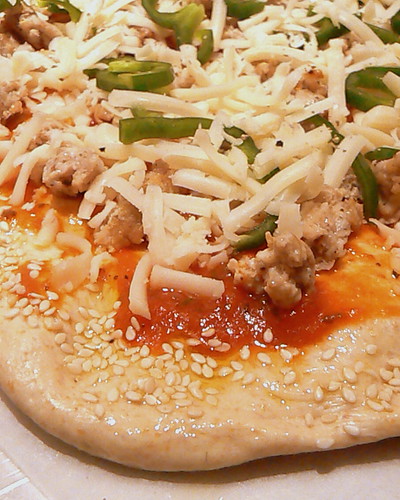
Making pizza sausage without a grinder.
Got some chicken and a big knife? Let’s make some sausage. Friday night means pizza here at the hermitage, and I use it as a chance to clean out the fridge. But what if you don’t have any… (Horrors!)… sausage on hand. Here’s a pretty quick way to produce the popular pizza topping.
Chicken
I bought a whole chicken at the beginning of the week, boned it, made stock. With the stock I made broccoli soup, and from half of the chicken I made a curry. I took the remaining breast and thigh for the sausage. It weighed about a pound, I diced it. The smaller the better.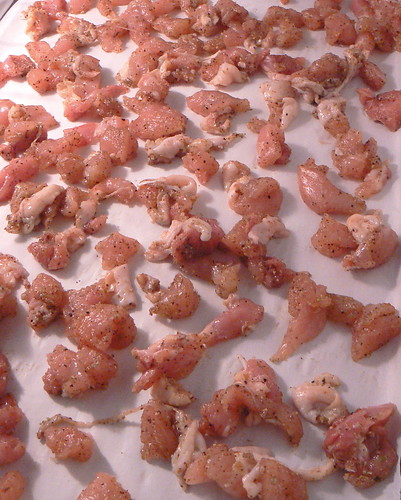
Mixing it up.
I mixed some salt and spices with the diced chicken, I let it rest in the fridge for 15 minutes. After the spices had a chance to soak in, I spread the mixture on a sheet pan lined with parchment and popped it into the freezer. It got good and crunchy in about 20 minutes.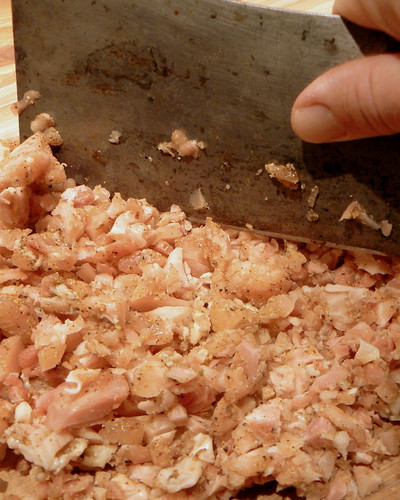
Chop Chop Chop
I got the cleaver and started chopping like I was on TV, fast and furious. It took 4 or 5 minutes to get it to the mince that I wanted. Yeah, I suppose I could have used a Cuisinart, but where’s that sport in that? Once chopped, I kneaded the sausage and added a splash of red wine vinegar. Then I cooked it.
Pizza time
My pizza stone cracked into three pieces about eight years ago but it still works. I put it on the top rack and put the oven on high for about an hour. As for the crust, I use a combination of Sapphire and whole wheat and give it an all day rise. The best discussion I’ve found about various pizza dough formulas is in the book American Pie, by Peter Reinhart. Go to the library and check it out.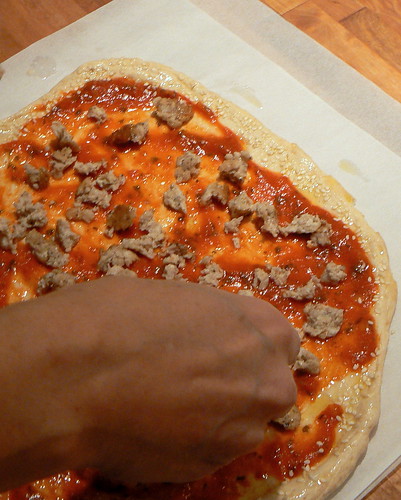
Here’s where a little heresy comes into play: I don’t care for the mess dusting my peel with semolina or cornmeal causes, so I put my pizza on parchment paper. I would cringe if I saw this in a professional operation (and I have), but at home it saves me from the odor of burning corn meal in the oven. When I’m ready to bake, I move the stone to the bottom of the oven and put in the pie. I pull the parchment after about five minutes and I can use it again for the next pie.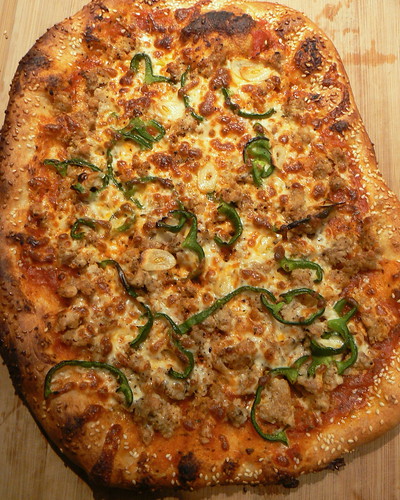
When done, cut into wedges, or squares if in Columbus, oh wait, pizza joints cut it in squares here too, and serve with beer. A fire in the fireplace, Myazaki movie on the tube, Friday night family fun.
Here’s the spices I used for 1 pound (450 grams) of Chicken:
8 g salt
3 g black peppercorns
3 g whole fennel
2 g whole coriander
1 g brown mustard seeds
Mix spices together and run them through a spice mill.
Happy Birthday Mom.
Cheers.
17 November, 2008
Smoked Fish in the Southland
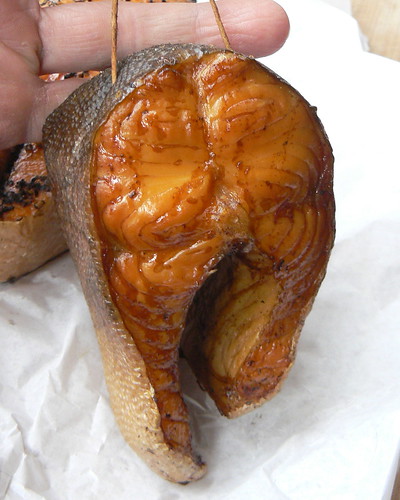
The Accidental Foodie goes to Calumet Fisheries.
Oh boy, I love smoked fish. It's not that hard to make, get some fish, fire up the smoker (really any type of grilling device set on lo) and wait a few hours, Hey Presto, smoky love from the sea. In fact I think it's so easy, that I would never consider buying it. I suppose I have become jaded, I see those golden smoked beauties in the cold case, and I feel like someone is trying to sell me a $20-dollar-a-pound secret that I already know. Well sometimes I'm told to put down my tongs and take a spin on the merry-go-round. And man what a ride.
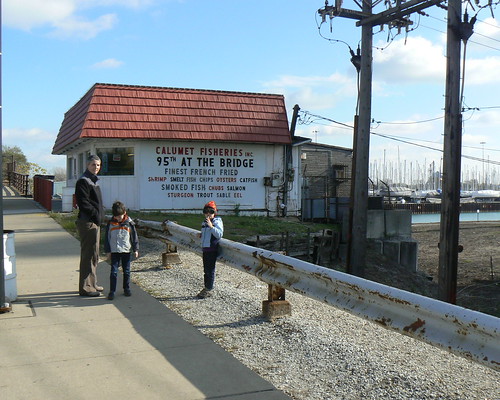
When someone says "fisheries" in Chicago, the person means a place that serves fried fish of some sort in a bag with fries and hot sauce. Calumet Fisheries is a little bit different in that they also offer fish smoked on the premises. We made the trip up to 95th ST, on a bright Sunday morning. We met Carlos who was working the counter and Ray who was tending to the smoker. They weren't too busy so they happily talked to Bonne Femme and me about what they do and showed us the smoker out back.
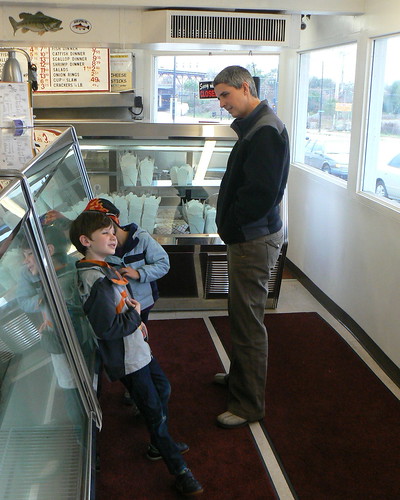
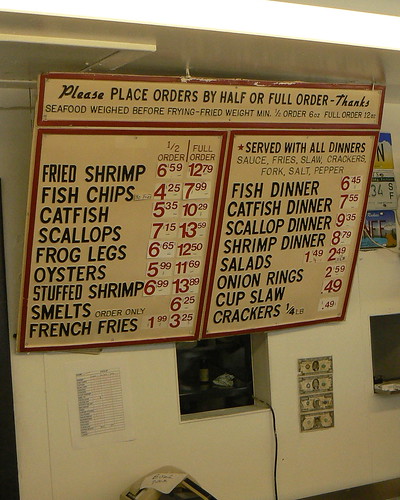
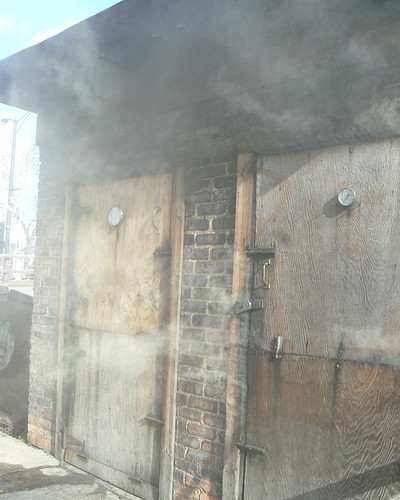
If for no other reason you should visit just to see the brick smokehouse. Perched between the store and the river, it is truly a relic of the past, no electric stainless steel chambers, just bricks, smoke and fish. The fish is hot smoked for about five hours with a mixture of hardwoods. Ray split some wood to give me an idea of the different aromas from the different woods.
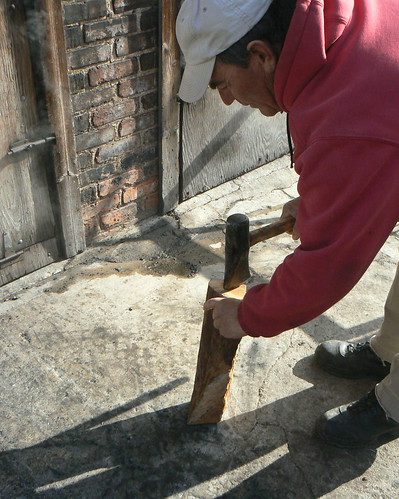
Ray brines the fish before smoking, he said he would be happy to tell me the recipe if had had one, he does it all to taste.
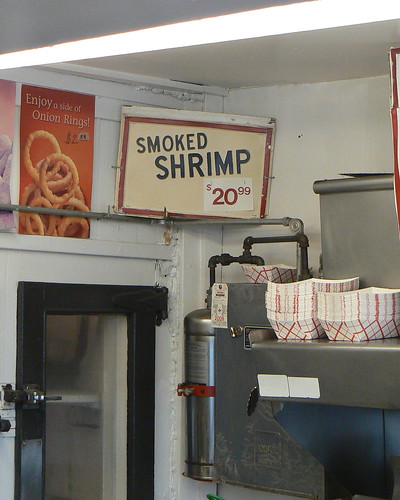
Back inside Carlos offers a sample of the smoked shrimp. Yum. We get to talking, he reveals that he went to culinary school at CHIC, Cooking and Hospitality Institute of Chicago. After getting his certificate he went to work at the casino down the road, but he didn't like it and came back to Calumet. All the school talk started making the boys antsy, Carlos asks me what I would like.
"I dunno what's coming out of the smoker?" Little did I know Bonne Femme was one step ahead of me, outside:

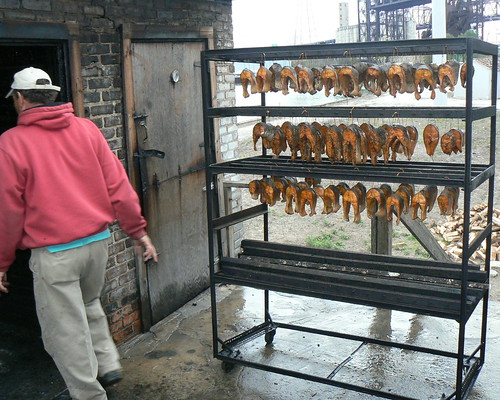
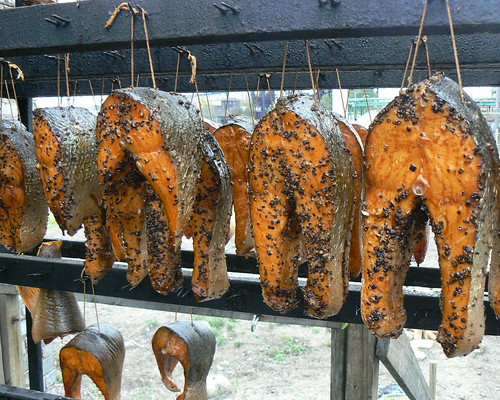
She zeroed in on a piece of trout and a piece of salmon with pepper and garlic.
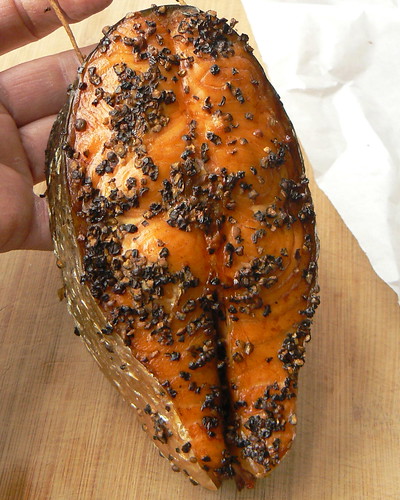
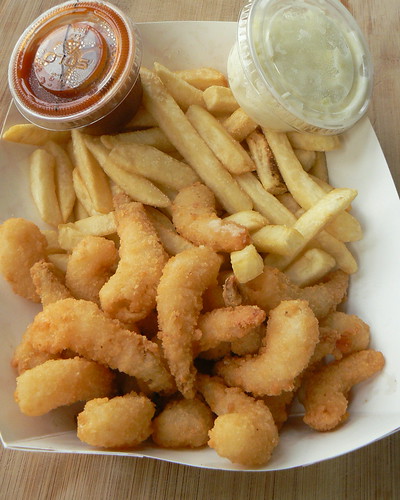
We got a shrimp dinner for the boys, they ate it all. The smoked fish doesn't come as a meal, you have to take it home and make your own magic. Smoked trout rillets maybe?
When You Visit:
While this part of town is remote, it is by no means intimidating. It is more industrial than anything else, on the other side of the bridge is one of Chicago's largest boat yards, Crowley's, they have a very nice ship's store. The bridge spans the Calumet river, not the Chicago. Calumet is also the name of the geologic region that starts roughly at 95th ST and stretches around the bottom of the Lake all the way to Michigan. There's a great book by Kenneth Schoon called Calumet Beginnings, that has a history of the area.
Calumet Fisheries
3259 E 95TH ST
Chicago, IL 60617
773-933-9855
calumetfisheries.com
Parking for Calumet Fisheries is on the street, and there are no tables. They are open 7 days 10am-10pm. Check it out.
Cheers.
Posted by mac at 13:45 1 comments
Labels: Accidental Foodie, Calumet Fisheries, Culinary school, Fish, Smoking, Southland

